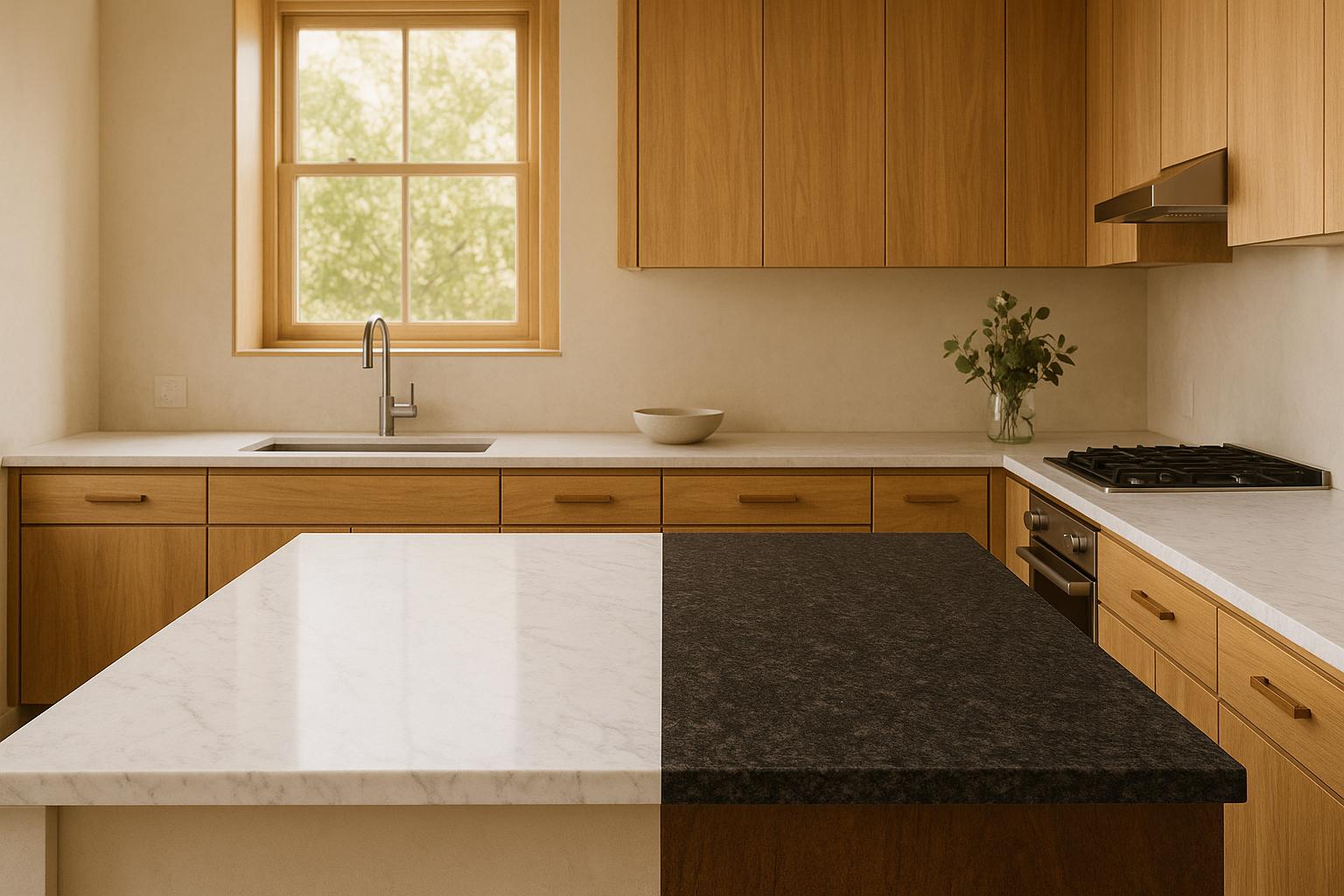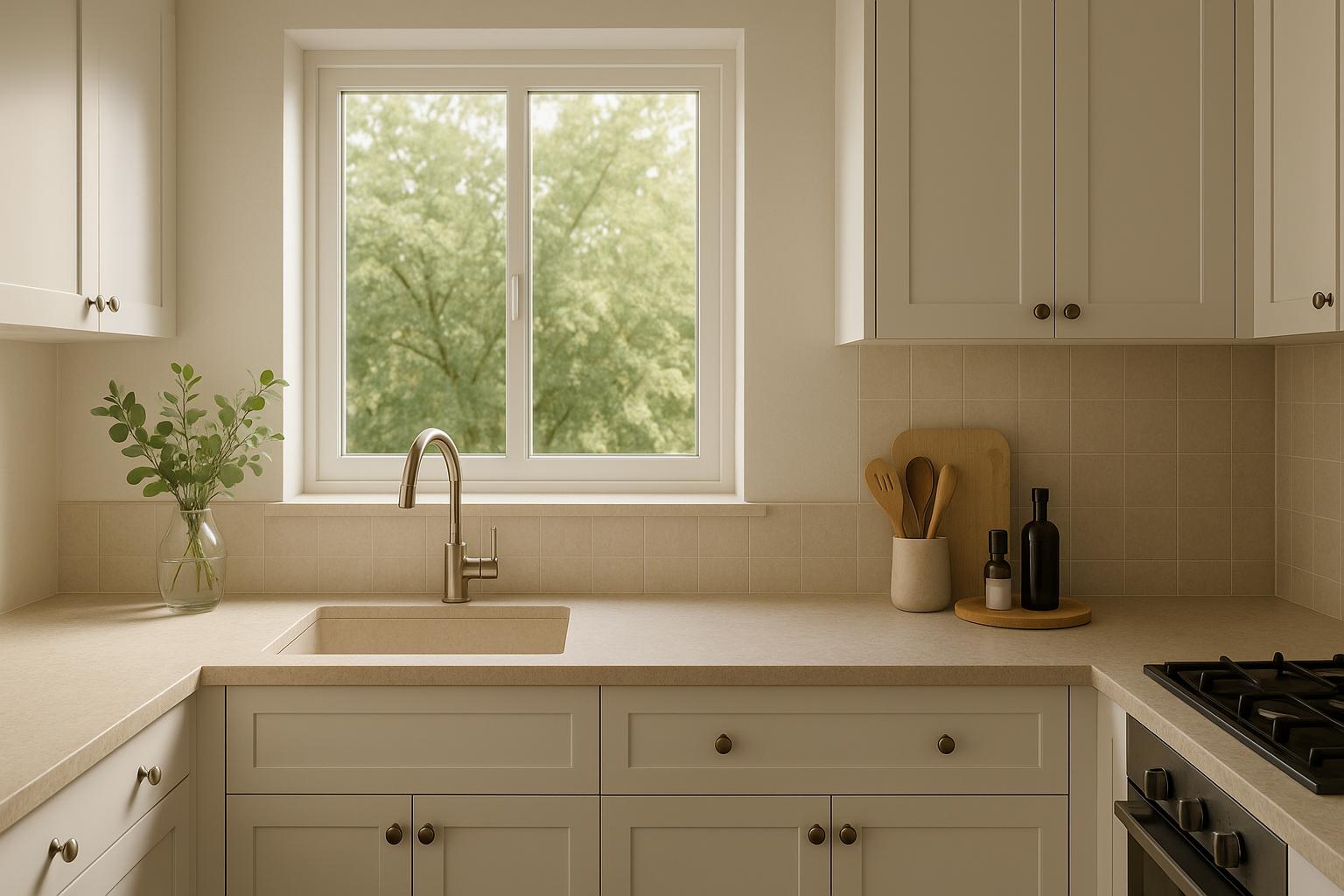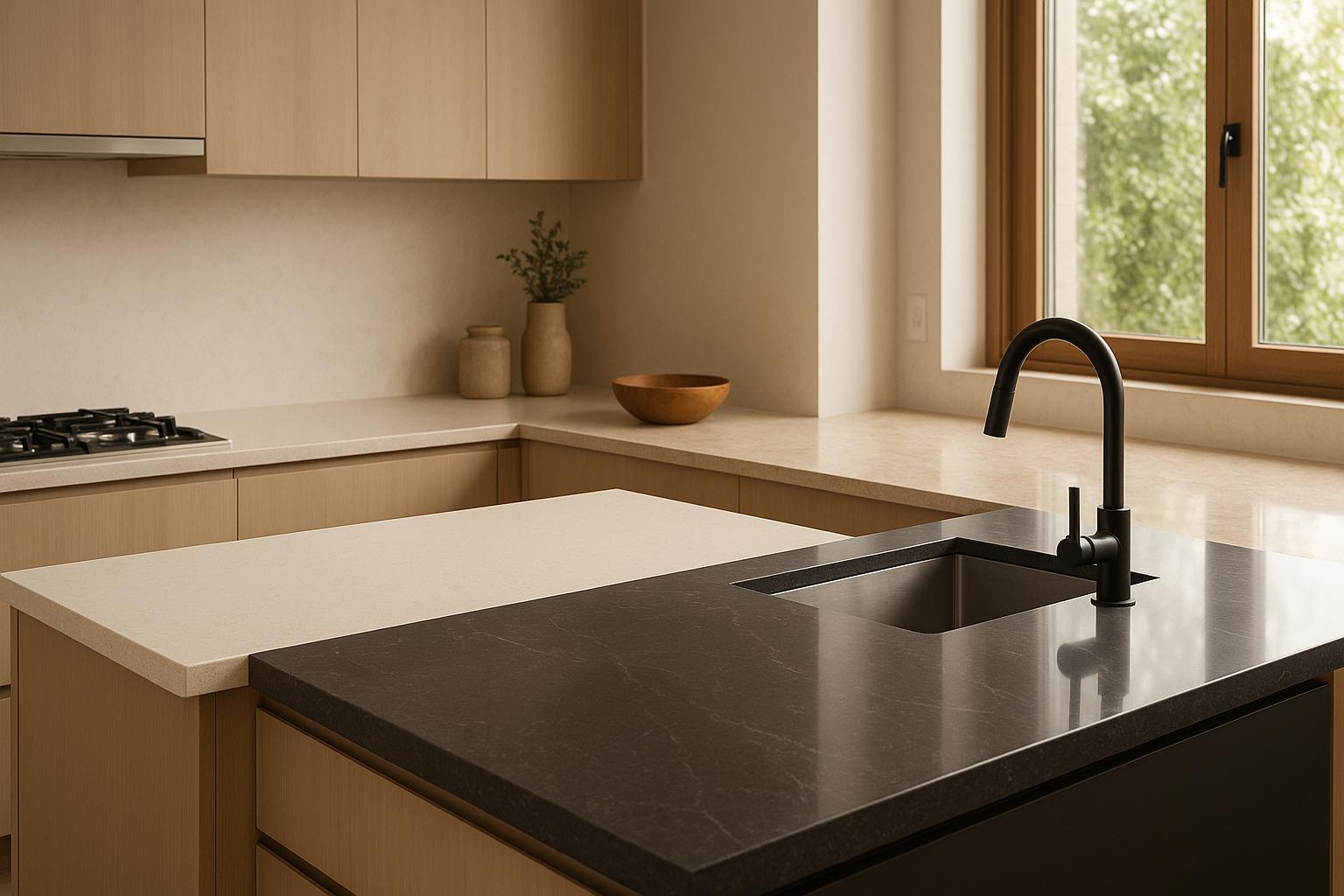When choosing between granite and marble countertops, it all comes down to your priorities: durability vs. elegance. Granite is tough, heat-resistant, and low-maintenance, making it ideal for busy kitchens. Marble, on the other hand, offers a luxurious, timeless appearance but requires more care due to its softer, porous nature. Both materials can increase your home’s appeal, but their differences in maintenance, cost, and performance play a big role in deciding which is right for you.
Key Differences:
- Durability: Granite is harder (Mohs 6–7) and resists scratches and stains better than marble (Mohs 3–5).
- Appearance: Granite has speckled patterns; marble is known for its veining and translucent quality.
- Maintenance: Granite needs resealing every 1–2 years; marble requires sealing every 6–12 months and is more prone to staining and etching.
- Cost: Granite averages $40–$200 per square foot; marble costs $40–$200, though some types can be more affordable.
Quick Comparison Table:
| Feature | Granite | Marble |
|---|---|---|
| Hardness | Mohs 6–7 (Very durable) | Mohs 3–5 (Softer) |
| Heat Resistance | Up to 1,200°F | Up to 1,004°F |
| Stain Resistance | Excellent when sealed | Prone to stains |
| Sealing Frequency | Every 1–2 years | Every 6–12 months |
| Cost | $40–$200/sq. ft. | $40–$200/sq. ft. |
Granite is better for high-use kitchens, while marble is perfect for those prioritizing style over practicality. Your decision should reflect your lifestyle, cooking habits, and willingness to maintain the material.
Granite vs. Marble Countertops – Marble.com TV Channel – Counter Intelligence

Granite Countertops: Pros and Cons
Granite countertops have become a go-to choice for kitchens and bathrooms, and it’s easy to see why. They’re known for their durability, natural beauty, and ability to elevate any space with a touch of elegance.
Advantages of Granite
Exceptional Durability
Granite is one of the hardest natural materials – second only to diamond. This toughness means it resists scratches, chips, and the wear and tear of daily life.
Heat Resistance
You can safely place hot pots and pans directly on granite without worrying about damage. Its ability to handle high temperatures makes it ideal for busy kitchens.
Distinctive Natural Patterns
No two granite slabs are alike. Each one features unique patterns and colors, turning your countertop into a one-of-a-kind centerpiece. This natural variation adds a sense of luxury and sophistication to your home.
Stain and Moisture Protection
When sealed properly, granite creates a strong barrier against spills like wine, coffee, and oil. This keeps your countertops looking clean and polished over time.
Easy Maintenance
Granite doesn’t demand much upkeep. A soft cloth, warm water, and mild soap are usually all you need for cleaning. Plus, resealing is only required every 1–2 years, making it relatively low-effort.
Boosts Home Value
Granite countertops are seen as an upscale feature that can increase your home’s appeal to potential buyers.
Versatile Finish Options
Whether you prefer polished, honed, or brushed finishes, granite offers a variety of styles to match your design goals and personal taste.
Chemical Resistance
Granite stands up well to many acids and bases, adding to its resilience in high-traffic areas like kitchens and bathrooms.
Disadvantages of Granite
While granite has many strengths, it does come with one notable requirement.
Periodic Sealing Needed
To maintain its stain and moisture resistance, granite needs to be resealed every 1–2 years. Skipping this step can compromise its protective layer over time.
Granite Pros and Cons Summary
| Advantages | Disadvantages |
|---|---|
| – Extremely durable (second only to diamond) – Heat-resistant for hot pots and pans – Unique, natural patterns that enhance aesthetics – Protects against stains and moisture when sealed – Low maintenance – simple cleaning and resealing every 1–2 years – Increases home market value – Wide range of finish options – Resistant to many chemicals |
– Requires resealing every 1–2 years |
Marble Countertops: Pros and Cons
Marble countertops are known for their timeless beauty, but they come with the need for careful upkeep compared to granite.
Advantages of Marble
Timeless Luxury and Elegance
Marble is celebrated for its natural veining and translucent quality, adding a touch of sophistication to any room.
Exceptional Longevity
When properly maintained, marble can last for generations – up to 100 years.
Cool Surface for Baking
Marble’s naturally cool surface is a favorite among bakers. Amy Sklar, founder of Amy Sklar Design, highlights its practical benefits:
"That’s why you’ll see a lot of old-school French bakeries that have marble counters. It helps keep the butter in the dough cool",.
Heat Resistance
While not impervious to heat, marble handles moderate heat well when paired with trivets or hot pads.
Boosts Home Value
Marble’s premium status and unique appearance can increase a home’s market value.
Antibacterial Qualities
Its smooth, non-porous surface naturally resists bacteria, making it a hygienic option for kitchens and bathrooms.
Versatile Design Options
Available in a wide range of colors and finishes, each marble slab is one-of-a-kind.
Affordable Options
Certain types of marble, like Carrara, can be more budget-friendly than some man-made materials. Depending on the variety and thickness, marble may even cost less than granite or quartz.
These benefits make marble a desirable choice, but they come with some trade-offs.
Disadvantages of Marble
Marble’s beauty is paired with a need for diligent care due to its natural vulnerabilities.
Easily Stained
Because marble is porous, spills can lead to permanent stains if not wiped up quickly.
Sensitive to Acids
Acidic substances like lemon juice, vinegar, or harsh cleaners can etch the surface, leaving dull or cloudy marks. Amy Sklar advises:
"A general rule of thumb is that acid is the enemy, so bleach, lemon-based cleaners, and vinegar can all etch the marble",.
Prone to Scratches and High Maintenance
With a hardness rating of Mohs 3–5, marble is relatively soft, making it susceptible to scratches. It also requires immediate cleanup and the use of pH-neutral cleaners.
Regular Sealing Needed
To protect against stains and etching, marble must be sealed every 6–12 months.
Heat Sensitivity
Although it can handle moderate heat, placing very hot items directly on marble can cause chipping or dull its finish.
Aging Over Time
Marble develops a patina as it oxidizes, which some homeowners appreciate as a "living finish." Others may prefer a consistently polished look.
Marble Pros and Cons Summary
| Advantages | Disadvantages |
|---|---|
| – Timeless luxury with unique natural veining – Can last up to 100 years with proper care – Naturally cool surface ideal for baking – Heat resistant for moderate kitchen use – Enhances home value – Natural antibacterial properties – Wide variety of colors and finishes – Each slab is unique – Can be more affordable than granite or quartz |
– Highly susceptible to stains from spills – Prone to etching from acidic substances – Scratches easily due to its softness – Requires sealing every 6–12 months – High maintenance with immediate cleanup needs – May chip or dull from extreme heat – Develops a patina over time |
Cost and Value Considerations
Understanding the costs of granite and marble can help you make a well-informed decision for your home.
Price Range of Granite and Marble
Granite countertops generally cost between $40 and $200 per square foot, with an average price of $70 per square foot. Builder-grade granite falls in the $40–$100 per square foot range, while mid-range options are priced around $60–$90. Premium granite can reach $90 to $250+ per square foot, and exotic varieties may go up to $400 per square foot.
Marble countertops have a similar price range of $40 to $200 per square foot, but their average cost is slightly lower at $60 per square foot. Budget-friendly options like Makrana marble cost $12 to $25 per square foot, while Carrara marble, a popular choice, is priced between $40 and $80 per square foot. Statuario marble ranges from $50 to $100 per square foot, and premium Calacatta marble starts at approximately $180 per square foot.
| Material | Average Cost Range (per sq. ft.) | Budget Options | Premium Options |
|---|---|---|---|
| Granite | $40–$200 | $40–$100 (builder-grade) | Up to $400 (exotic) |
| Marble | $40–$200 | $12–$25 (Makrana) | $180+ (Calacatta) |
Beyond material prices, installation costs significantly affect your overall budget.
Factors Affecting Installation Costs
Several factors can influence the cost of installing granite or marble countertops.
Complex designs featuring intricate cuts, curves, or decorative edges can increase project costs by 20–30%. While standard edges like eased or bullnose are typically included in the base price, more decorative edges such as ogee or Dupont can add up to $40 per square foot.
Custom features also contribute to higher expenses. For example, undermount sink cutouts typically cost $200–$300, whereas cooktop cutouts run about $100 each. Undermount sinks, which require polished cuts, tend to be pricier than inset sinks.
Logistical challenges, such as narrow doorways, stairs, or upper floors without elevator access, can increase labor and transportation costs. Additionally, larger and heavier stone slabs may require extra manpower or specialized equipment.
Professional installation costs for granite range between $35 and $75 per square foot, adding $300 to $500 to most projects. Contractors typically charge $30 to $50 per hour, with total labor costs for a project running between $400 and $1,000. For a standard 50-square-foot kitchen, the complete installation cost is usually between $2,000 and $4,000.
Considering the long-term benefits of granite and marble is also essential when weighing your options.
Resale Value and Long-Term Investment
The enduring durability of granite and marble makes them appealing for long-term value, particularly when it comes to resale.
Granite countertops often provide a better return on investment, with homeowners recovering around 50–75% of their costs during resale.
"It’s assumed that granite countertops will last 100 years or more… a home seller can expect to recover around 25% of the retail cost of recently installed granite tops when they are part of a pleasing kitchen design."
– Forbes
Marble countertops, while requiring more upkeep, still offer a solid resale value, with homeowners recouping 25–50% of their investment.
"Both marble and granite countertops, if maintained properly, offer significant resale value. Granite, being slightly more durable, is less prone to showing damage and may offer better resale value, if the marble is not properly cared for."
– Freedom Stone Fabricators
Opting for neutral colors and simple designs can further enhance the resale appeal of your countertops. Regular maintenance is key to preserving their natural beauty and maximizing your return on investment.
sbb-itb-e397dd0
Granite vs Marble: Performance and Maintenance
Let’s break down how granite and marble compare in terms of performance and maintenance.
Durability Comparison
Granite and marble differ significantly in hardness and composition, which directly impacts their durability. Granite scores between 6–7 on the Mohs scale, making it highly scratch-resistant. Marble, on the other hand, ranks lower at 3–4, meaning it’s more prone to scratches and damage. When it comes to structural strength, granite boasts a compressive strength of 130–200 MPa, outclassing marble’s 80–120 MPa. Granite also handles heat better, tolerating temperatures up to 1,200°F (650°C), while marble withstands up to 1,004°F (540°C) but is more vulnerable to stress fractures from sudden temperature changes. Additionally, granite’s lower water absorption rate (0.2–0.4%) makes it less likely to stain compared to marble (0.5–1%). These differences explain why granite is often favored for high-use areas like kitchens.
Maintenance Requirements
Granite is relatively low-maintenance – clean it daily with mild soap and water. Marble, however, requires more attention. Use pH-neutral cleaners and clean up spills immediately, especially acidic ones like lemon juice, wine, or vinegar, as they can cause etching. Marble’s porous nature also means it needs sealing more frequently, typically every 3–6 months, compared to granite’s 1–2 years. Over time, marble develops a natural patina that some homeowners find appealing, but professional refinishing may be necessary to address scratches or etching.
"Granite generally emerges as the more practical choice [for kitchen worktops]. Its superior scratch resistance, stain resistance, and immunity to etching make it well-suited to the demands of food preparation."
– Imperial Stone Group
To check if resealing is needed, place a few drops of water on the surface. If the water absorbs or darkens the stone within 10–15 minutes, it’s time to reseal.
Performance Comparison Table
Here’s a quick side-by-side look at how granite and marble stack up:
| Feature | Granite | Marble |
|---|---|---|
| Hardness (Mohs Scale) | 6–7 (Very Durable) | 3–4 (Softer) |
| Scratch Resistance | 8/10 – Highly resistant | 6/10 – More susceptible |
| Heat Resistance | 9/10 – Up to 1,200°F (650°C) | 8/10 – Up to 1,004°F (540°C) |
| Stain Resistance | 8/10 – Excellent when sealed | 6/10 – Requires prompt cleaning |
| Porousness | 8/10 – Low porosity | 6/10 – More porous |
| Sealing Frequency | Every 1–2 years | Every 3–6 months |
| Daily Maintenance | Low – mild soap and water | High – pH-neutral cleaners needed |
| Etching Resistance | Resistant to acids | Susceptible to acids |
For kitchens with heavy use, granite’s durability and low maintenance make it the better option. Marble, however, remains a favorite for those who value its aesthetic charm and are willing to put in the extra effort.
"Marble is a viable choice for kitchens and we know this because we work with many customers who use this stone for this room. It appeals to homeowners who prioritize aesthetics and are committed to careful maintenance."
– Imperial Stone Group
When properly sealed and maintained, both granite and marble can last over 50 years while retaining their beauty and functionality.
Choosing the Right Material for Your Project
When deciding between granite and marble, the choice really comes down to how you use your kitchen and what kind of upkeep you’re willing to commit to. Your daily habits, maintenance preferences, and long-term goals all play a role in making the best decision.
Factors to Consider When Choosing
How you use your kitchen is one of the biggest factors to weigh. If your kitchen is a hub of activity – with frequent cooking, entertaining, or daily use – granite is a smart pick. Its durability, scratch resistance, and ability to handle heat make it a practical option for busy households.
On the other hand, if your kitchen use is more occasional or you prioritize aesthetics over functionality, marble might be a better fit. Its elegant appearance adds a touch of sophistication, though it does require more care to maintain that look. For example, if you’re someone who loves takeout and rarely cooks elaborate meals, marble’s upkeep might feel manageable.
Granite also stands out when it comes to resisting stains and etching, especially if you often work with acidic ingredients like lemon juice or vinegar. Marble, while stunning, is more prone to damage from spills and requires immediate cleanup to avoid long-term issues.
For homes with kids or active households, granite’s durability can be a lifesaver. It’s more forgiving when it comes to spills and general wear and tear, making it a practical choice for family kitchens.
Maintenance is another key consideration. Granite needs sealing every 1–2 years and can be cleaned with mild soap, while marble demands a bit more attention. You’ll need to seal it every 6–12 months, clean up spills promptly, and stick to pH-neutral cleaners to keep it looking its best.
Finally, think about the long-term appeal. Over time, marble develops a patina that many homeowners find charming and full of character. Granite, on the other hand, tends to maintain its consistent look throughout its lifespan, which appeals to those who prefer a more uniform appearance.
Best Applications for Granite and Marble
Granite is a workhorse in high-traffic areas, making it ideal for countertops, sinks, and even outdoor kitchens where weather resistance is a must. Its heat resistance also makes it perfect for spots near cooktops and ovens. You can also use granite creatively for contrasting island tops, wall cladding, or integrated drainboards.
Marble, meanwhile, shines in spaces where its beauty can take center stage. It’s perfect for baking stations, thanks to its naturally cool surface that’s ideal for rolling out dough. It also works well in decorative accents, low-traffic areas, and formal spaces. Some unique ways to incorporate marble include backlit backsplashes, integrated sinks, hood surrounds, or marble-clad islands that double as statement pieces.
Many homeowners find a balance by mixing the two materials. For example, you could use granite for the main work surfaces where durability is key and reserve marble for decorative elements or areas with lighter use. This way, you get the best of both worlds – granite’s toughness and marble’s elegance.
Making the Final Decision
Once you’ve considered your needs and style preferences, it’s time to focus on the practical details. Start by evaluating how your kitchen functions on a daily basis. If you have a busy household with multiple cooks and frequent gatherings, granite’s low-maintenance durability is likely the better choice. For kitchens used primarily for light meal prep or as a formal space, marble can work beautifully despite its higher maintenance requirements.
Budget is another factor. Marble typically costs between $50–$150 per square foot installed, while granite ranges from $40–$100. However, don’t forget to account for long-term maintenance costs. Marble’s frequent sealing and specialized cleaning supplies can add up over time.
Your design goals also play a big role. If you’re drawn to marble’s luxurious veining and are willing to invest in its care, it can elevate your kitchen’s aesthetic. Granite, with its wide range of colors and patterns, is versatile enough to complement modern, traditional, or rustic designs.
"What sets marble and granite apart is their versatility. Whether you’re aiming for a sleek, modern look or a more traditional aesthetic, these stones can be incorporated seamlessly into any design scheme."
- Interior designer with over two decades of experience
Lastly, think about your home’s resale value. Both materials add appeal, but granite’s lower maintenance and broad appeal often make it a favorite among potential buyers.
MI Stone: Your Partner in Kitchen Renovations

Thinking about transforming your kitchen? MI Stone specializes in expert granite and marble installations that bring your vision to life. Dive into their services, extensive stone options, and hands-on support to see how they can make your renovation seamless.
Expert Services in Natural Stone
MI Stone takes the hassle out of natural stone installations, handling everything from precise measurements to flawless finishes. Their custom templates ensure your countertops align perfectly with cabinets and appliances, avoiding costly mistakes during installation.
Using advanced tools, each stone is meticulously cut, polished, and finished to meet exact specifications. But MI Stone doesn’t stop at countertops – they also offer kitchen renovation services, including cabinetry options. This integrated approach lets you coordinate your stone choice with cabinet styles, hardware, and overall design, making the entire process smoother and ensuring consistent quality.
Their installation team brings deep expertise in handling both granite and marble. They understand granite’s need for robust support structures and the delicate care marble requires during transport and installation. This attention to detail safeguards your investment and ensures your surfaces remain durable and beautiful for years.
Extensive Selection of Granite and Marble
At MI Stone’s showroom, you’ll find an impressive array of natural stones sourced from around the globe. This international variety means you’re not limited to local options – you can choose from a wide range of colors, patterns, and textures to match your design vision.
The collection includes granite and marble in both slabs and tiles, catering to projects of all sizes and budgets. Slabs provide seamless surfaces with minimal joints, while tiles offer a cost-effective solution for larger spaces or specific design needs.
Beyond granite and marble, the showroom also features quartz, onyx, and porcelain, giving you even more options to experiment with. For example, you could pair granite countertops with marble accents or use quartz for high-traffic areas while incorporating natural stone for decorative touches.
This global sourcing approach ensures access to timeless classics like Carrara marble, bold granite with striking veining, and modern patterns that suit contemporary designs. Whether you prefer traditional elegance or cutting-edge styles, MI Stone’s selection has something for every taste and functional need.
Comprehensive Installation and Design Support
MI Stone doesn’t just provide materials – they guide you through the entire renovation process. Their design consultations and installation scheduling are tailored to fit seamlessly into your project timeline, minimizing disruptions and ensuring top-notch results.
Their design team works closely with you to visualize how different stones will look under your kitchen’s lighting and explains how various finishes will perform in your space. They can recommend combinations that balance style with practicality, helping you achieve your dream kitchen without compromising functionality.
From the initial planning stages to the final installation, MI Stone ensures consistent communication and attention to detail. If adjustments are needed along the way, you’ll be working with a team that knows your project inside and out.
Even after installation, MI Stone remains a resource. They provide detailed care and maintenance instructions tailored to your chosen stone. Whether you’ve selected granite or marble, you’ll learn how to clean, seal, and maintain your surfaces to keep them looking stunning for years to come.
Conclusion: Granite vs Marble
Key Points Summary
Each stone brings its own set of advantages and challenges, and we’ve broken them down into four key factors to help you decide:
- Durability: Granite’s tougher composition stands up better to chips, scratches, and everyday wear, making it a solid choice for busy kitchens.
- Appearance: Granite showcases a granular texture with a mix of flecks and veins in various colors, while marble offers a smooth surface with graceful, eye-catching veining.
- Cost: On average, granite is more budget-friendly than marble, with potential savings ranging from $25–$50 per square foot.
- Maintenance: Granite requires less frequent sealing and is more forgiving when it comes to spills, making it easier to maintain.
"Both granite and marble are excellent choices for kitchen countertops, but they cater to different needs and styles."
Final Thoughts on Countertop Selection
When deciding between granite and marble, think about how each material fits your lifestyle, kitchen habits, and maintenance preferences. Your choice should reflect your daily needs and budget.
If you cook often, have kids, or want a low-maintenance option, granite is a practical pick due to its durability and resistance to stains. In fact, surveys highlight granite as a top choice for high-use areas.
On the other hand, marble offers timeless elegance and a naturally cool surface, which is especially valued by bakers and pastry chefs for tasks like rolling dough or working with chocolate. However, it does require more care to keep it looking its best.
Both materials can enhance your home’s resale value, but granite’s lower upkeep often makes it a more cost-effective investment. Ultimately, the best choice depends on your personal style, cooking habits, and how much maintenance effort you’re willing to put in. As GMS Werks aptly states:
"The final decision will depend on your personal preferences, your willingness to commit to the necessary maintenance and your budget."
For a tailored recommendation that matches your space and design goals, consulting with a professional can make all the difference.
FAQs
What are the main differences in maintaining granite and marble countertops, and how do they affect their longevity?
Granite countertops are celebrated for being durable and easy to care for. A quick seal once a year is usually enough to keep them protected from stains, and with minimal effort, they can last for decades. Plus, their natural resistance to scratches and heat makes them a great fit for busy kitchens where spills and hot pans are part of daily life.
Marble, while undeniably stunning, is a bit more high-maintenance. Its porous surface needs sealing every 3 to 6 months, and it demands careful cleaning to prevent damage from acidic substances like lemon juice or vinegar. Over time, marble can develop stains or etching, which might alter its polished look.
Granite stands out as a tough, low-maintenance choice, while marble offers timeless elegance but requires more attention to keep it looking its best.
What are the differences in cost and value between granite and marble countertops, including installation and resale potential?
In the U.S., marble countertops tend to come with a higher price tag compared to granite. The installation costs for marble usually fall between $125 and over $200 per square foot, while granite offers a more budget-friendly option, ranging from $43 to $175 per square foot. The premium price of marble reflects its luxurious and sophisticated appearance, but it does come with the trade-off of requiring more upkeep, which could impact its value over time.
Both materials have the potential to boost a home’s resale value. Marble’s classic and elegant look often appeals to buyers seeking a high-end aesthetic, while granite stands out for its durability and affordability, making it a practical choice for a broader range of homeowners. Deciding between the two ultimately comes down to your budget, style preferences, and how much effort you’re willing to put into maintenance. Either option can transform a space and add significant appeal to your home.
Is granite a better option than marble for a busy kitchen, and what makes it suitable for high-use areas?
Granite stands out as a top pick for bustling kitchens thanks to its toughness and resistance to scratches, stains, and heat. These features make it a reliable choice for countertops that endure constant use and activity. With the right care, granite can retain its beauty and functionality for decades, making it a long-lasting investment.
On the other hand, marble offers a more refined and elegant look but comes with certain limitations. It’s softer and more susceptible to etching, staining, and general wear, particularly in spaces with heavy daily use. For kitchens that see a lot of action, granite proves to be the more practical and easier-to-maintain option.



